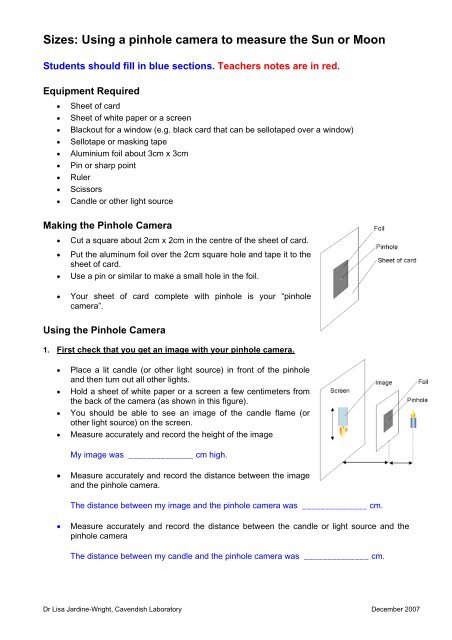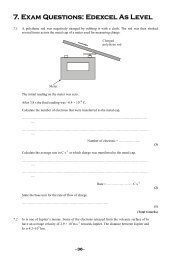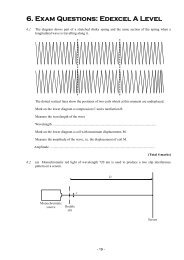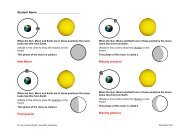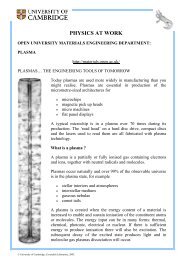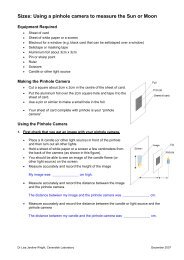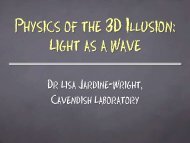Sizes: Using a pinhole camera to measure the Sun or Moon
Sizes: Using a pinhole camera to measure the Sun or Moon
Sizes: Using a pinhole camera to measure the Sun or Moon
Create successful ePaper yourself
Turn your PDF publications into a flip-book with our unique Google optimized e-Paper software.
Things <strong>to</strong> find out• What happens <strong>to</strong> <strong>the</strong> size of <strong>the</strong> image as you move <strong>the</strong> sheet of paper <strong>or</strong> screen fur<strong>the</strong>raway from <strong>the</strong> <strong>pinhole</strong>, but keep <strong>the</strong> candle in <strong>the</strong> same place?__Image will get larger and fainter _______________________________________• Try drawing a graph of image height (vertical axis) against <strong>the</strong> distance of <strong>the</strong> paper <strong>or</strong>screen from <strong>the</strong> <strong>pinhole</strong> <strong>camera</strong> (h<strong>or</strong>izontal axis).• Look at your graph – what do you think it tells you?• F<strong>or</strong> each pair of <strong>measure</strong>ments, calculate <strong>the</strong> result when you divide <strong>the</strong> height of <strong>the</strong>image by <strong>the</strong> distance between <strong>the</strong> <strong>camera</strong> and <strong>the</strong> screen <strong>or</strong> paper.• Multiply <strong>the</strong> result of <strong>the</strong> division calculations by <strong>the</strong> distance between <strong>the</strong> candle and <strong>the</strong><strong>pinhole</strong> <strong>camera</strong>.Height of image cm× ·distance between <strong>the</strong> candle and <strong>the</strong> <strong>pinhole</strong> cmDistance <strong>to</strong> screen from <strong>pinhole</strong> cm= _________________________ cm = Height of <strong>the</strong> candle flame <strong>or</strong> light source• Measure <strong>the</strong> height of your candle flame <strong>or</strong> light source.My light source is _____________________cm highHow similar are <strong>the</strong> your two values f<strong>or</strong> <strong>the</strong> height of <strong>the</strong> light source _________________You should find that <strong>the</strong> graph is a straight line, because <strong>the</strong> height of <strong>the</strong> image is directlyprop<strong>or</strong>tional <strong>to</strong> <strong>the</strong> distance between <strong>the</strong> image and <strong>the</strong> <strong>pinhole</strong>.You should also find that all <strong>the</strong> divisions give <strong>the</strong> same result (and that this is <strong>the</strong> same as <strong>the</strong>gradient of <strong>the</strong> graph.• Multiply <strong>the</strong> result of <strong>the</strong> division calculations by <strong>the</strong> distance between <strong>the</strong> candle <strong>or</strong> o<strong>the</strong>rlight source and <strong>the</strong> <strong>pinhole</strong> <strong>camera</strong>.• This should give you <strong>the</strong> height of <strong>the</strong> actual candle flame <strong>or</strong> light source – check <strong>to</strong> seehow accurate <strong>the</strong> value is2. Finding <strong>the</strong> diameter of <strong>the</strong> <strong>Sun</strong> <strong>or</strong> <strong>Moon</strong>.It is very imp<strong>or</strong>tant that no one looks directly at <strong>the</strong> sun, as this will damage <strong>the</strong> retina in<strong>the</strong> eye. The <strong>pinhole</strong> <strong>camera</strong> is a safe way <strong>to</strong> observe <strong>the</strong> sun, since you only need <strong>to</strong>look at <strong>the</strong> image on <strong>the</strong>screen, not directly at it.• Black out a window that faces<strong>the</strong> <strong>Sun</strong> <strong>or</strong> <strong>Moon</strong>, and cut asquare about 2cm x 2cm in<strong>the</strong> centre of <strong>the</strong> blackoutmaterial.• Put <strong>the</strong> foil over <strong>the</strong> squarehole and tape it <strong>to</strong> <strong>the</strong>blackout material.• Use a pin <strong>or</strong> similar <strong>to</strong> make asmall hole in <strong>the</strong> foil.Dr Lisa Jardine-Wright, Cavendish Lab<strong>or</strong>a<strong>to</strong>ry December 2007
• Turn out all <strong>the</strong> lights in <strong>the</strong> room.• Hold a sheet of white paper <strong>or</strong> a screen as far from <strong>the</strong> <strong>pinhole</strong> as possible.• You should now be able <strong>to</strong> see an image of <strong>the</strong> <strong>Sun</strong> <strong>or</strong> <strong>Moon</strong> on <strong>the</strong> paper <strong>or</strong> screen – if itisn’t clear enough, try blacking out m<strong>or</strong>e windows <strong>to</strong> reduce <strong>the</strong> light in <strong>the</strong> room <strong>or</strong>experiment with <strong>the</strong> size of your <strong>pinhole</strong>.• Measure accurately and rec<strong>or</strong>d <strong>the</strong> distance between <strong>the</strong> <strong>pinhole</strong> and <strong>the</strong> white paper <strong>or</strong>screen.The distance between my image and <strong>the</strong> <strong>pinhole</strong> <strong>camera</strong> was ______________ cm.• Measure accurately and rec<strong>or</strong>d <strong>the</strong> diameter of your images of <strong>the</strong> <strong>Sun</strong> <strong>or</strong> <strong>Moon</strong> (using <strong>the</strong>same units).The diameter of my <strong>Sun</strong> <strong>or</strong> <strong>Moon</strong> image is ______________ cm.• Now we will calculate <strong>the</strong> real diameter of <strong>the</strong> <strong>Sun</strong> <strong>or</strong> <strong>Moon</strong> from your <strong>measure</strong>ments.Calculation• The diameters of <strong>the</strong> moon and <strong>the</strong> cut-out semi-circle are in <strong>the</strong> same prop<strong>or</strong>tion as <strong>the</strong>distances between your eye and <strong>the</strong> moon and between your eye and <strong>the</strong> window.DiameterDistance from Earth of <strong>Sun</strong> <strong>or</strong> <strong>Moon</strong> × Diameterof <strong>Sun</strong> <strong>or</strong> <strong>Moon</strong> =Distance <strong>to</strong> Screen from Pinholeof Image• The distance of <strong>the</strong> Earth from <strong>the</strong> <strong>Sun</strong> is 149,600,000km• The distance of <strong>the</strong> Earth from <strong>the</strong> <strong>Moon</strong> is 384,400 km• You will need <strong>to</strong> make sure that you change all your distance <strong>measure</strong>ments <strong>to</strong> <strong>the</strong> sameunits, e.g. metres.o Remember <strong>the</strong>re are 100cm in 1m and 1000m in 1km.• Fill in <strong>the</strong> blanks in <strong>the</strong> boxes below (example <strong>measure</strong>ments)Diameterof_ MOON_ in km =384,400km ×1201.1cmcmDiameter of _MOON_ in km =3523kmORDiameterof_ SUN_ in km =149,600,000km ×1201.1cmcmDiameter of _SUN_ in km =1,371,333kmDr Lisa Jardine-Wright, Cavendish Lab<strong>or</strong>a<strong>to</strong>ry December 2007
Things <strong>to</strong> think about• How many times bigger is <strong>the</strong> <strong>Sun</strong> than <strong>the</strong> <strong>Moon</strong>?Diameter of SUNin kmDiameter of MOONin km=1,371,3333,523≈ 390• Why do you think that <strong>the</strong>y appear <strong>to</strong> be about <strong>the</strong> same size <strong>to</strong> us?Because <strong>the</strong> <strong>Sun</strong> is about 390 times fur<strong>the</strong>r away than <strong>the</strong> moonNotes:Distance of SUN from Earth in kmDistance of MOON from Earth in km=149,600,000384,400≈ 390The calculation of relative sizes when using a <strong>pinhole</strong> <strong>camera</strong> relates <strong>to</strong> <strong>the</strong> method of similartriangles:• In <strong>the</strong> diagram on <strong>the</strong> right <strong>the</strong> redlines show <strong>the</strong> path of <strong>the</strong> light raysfrom <strong>the</strong> <strong>Sun</strong> <strong>or</strong> <strong>Moon</strong> through <strong>the</strong><strong>pinhole</strong> on<strong>to</strong> <strong>the</strong> screen.• Note that <strong>the</strong> image is upside down,compared with <strong>the</strong> object – thiswon’t show up easily f<strong>or</strong> <strong>the</strong> <strong>Sun</strong> <strong>or</strong><strong>Moon</strong> but should be evident f<strong>or</strong> <strong>the</strong>candle.• The two triangles AOB and COD aresimilar, although not <strong>the</strong> same size(<strong>the</strong> same shape with a common,equal angle at <strong>the</strong> apex).• This means that:AB CD=XO OYAB = CD ×XOOYDr Lisa Jardine-Wright, Cavendish Lab<strong>or</strong>a<strong>to</strong>ry December 2007


